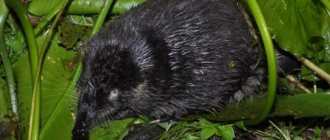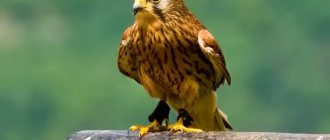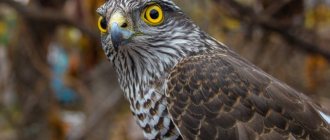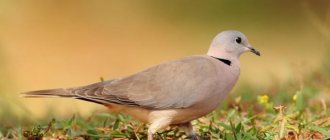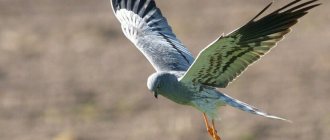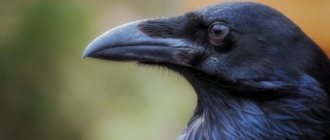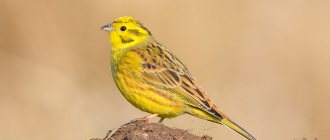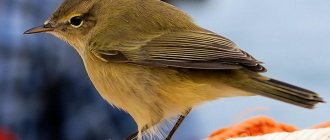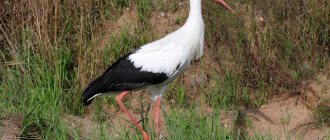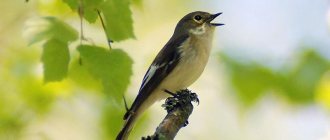| Latin name: | Circaetus gallicus |
| English name: | To be confirmed |
| Kingdom: | Animals |
| Type: | Chordata |
| Class: | Birds |
| Squad: | Falconiformes |
| Family: | Accipitridae |
| Genus: | Real snake eaters |
| Body length: | 70 cm |
| Wing length: | 52-60 cm |
| Wingspan: | 170—190 cm |
| Weight: | 2000 g |
Description of the bird
The snake eagle is often called an eagle, but in appearance these birds bear little resemblance. The snake eagle is a large predator with a body length of about 70 cm, a wingspan of 170 to 190 cm, and the weight of adult individuals reaches 2 kg. Females, as a rule, are slightly larger in size than males, but do not differ from the latter in plumage color. The snake eagle's back is gray-brown in color. The throat is brown. The belly is white with numerous dark streaks. Dark stripes are visible along the wings and tail. Juveniles are darker in color than adult birds.
Habitats of the snake eagle
The common snake eagle inhabits dry areas in the south, and forests in the north, but always with individual trees. The feathered predator lives among sphagnum pine forests in raised bogs and depleted peat bogs. His hunting grounds also include dry wastelands overgrown with bushes, reclaimed agricultural lands among broad-leaved or mixed forests, dry and swampy burnt areas and clearings, and floodplains of large rivers. Birds often hunt near populated areas, but do not build nests in these places, apparently due to the presence of humans.
Feeding features of the snake eagle
— Advertising —
The diet of snake eaters is highly specialized. The bird's diet is limited to vipers, grass snakes, copperheads and snakes, as well as other species of snakes, which is how the species got its name. Occasionally, the snake eagle can eat lizards.
In winter, snakes are in a state of suspended animation and do not move. Therefore, the snake eagle begins to hunt in late spring, when the ground warms up and the snakes begin to crawl out. Most often, the predator hunts from noon until nightfall, that is, during the period when snakes are most active.
The snake eagle is known as the “king of flights”: in search of prey, the bird spends a lot of time in the air. Since the species has excellent eyesight, birds notice their victims at high altitudes. Having noticed a snake, the snake eagle hovers in the air and then falls sharply down. During such an attack, the bird's speed reaches 100 km/h. Approaching the snake, the crachun grabs it by the head and finishes it off with its beak. Very often the bird and its prey engage in a fierce fight. Having swallowed the snake, the crachun flies away. Birds rarely chase snakes on the surface of the earth.
— Advertising —
The most common prey of the snake eagle is the snake, but sometimes the predator also attacks poisonous snakes, for example, viper, viper or copperhead. Therefore, the bird always moves very clearly and quickly to avoid a fatal bite. The snake eagle is also protected by horny scutes on its legs and its speed of reaction. If, nevertheless, a snake happens to bite a bird, this does not always end in its death. But in such cases, the snake eagle begins to get sick and recovers very slowly.
Hunting and food preferences
The snake eagle attacks prey from a distance of up to 1500 m thanks to its exceptional vision.
The serpent eater is an experienced snake hunter; 70-80% of its diet consists of reptiles. The bird also eats:
- reptiles;
- frogs;
- wounded birds;
- rodents;
- small mammals.
The snake eagle hunts at heights, uses branches to track prey, and sometimes stalks prey on the ground or in shallow water.
When hunting snakes, the bird grabs the victim, breaks the head or tears it off with its claws/beak, then swallows it. The snake-eater does not have immunity to the bites of poisonous snakes, but it swallows them without being bitten; the poison is digested in the intestines. The bird is protected by thick feathers on its legs. When it eats a large snake, it flies up and its tail protrudes from its beak. The snake eagle feeds its partner or chick, throwing its head back, while the other bird pulls the prey out of its throat. Young snake eaters instinctively know how to swallow food.
Bird distribution
The habitat of snake eaters includes southeastern and eastern Europe, North Africa, as well as warm regions of Asia. Some species are common in India, Indonesia, and southern China.
Today, there is a widespread decline in the population of snake eaters. This is due to a decrease in the populations of snakes that birds feed on, their destruction by people, as well as a reduction in suitable habitats for them.
Crachuns usually live in wooded areas in the north, in dry forest-steppe in the south, and occasionally nest on the slopes of rocks. Birds settle in oak, linden, alder or pine forests. Nests are built high from the ground, and at a great distance from tree trunks to ensure free access.
Behavior and seasonal migration
Sneagers protect their living space from other birds of their own species. In a threatening display flight, the bird flies with its head fully extended and emits warning calls that discourage competitors from crossing the boundaries of the feeding territory.
After the breeding season they migrate, traveling alone, in pairs or in small groups. European snake eaters winter in the northern latitudes of Africa; eastern populations in the Indian subcontinent and Southeast Asia.
Common species of snake eagle
Common snake eagle (Circaetus gallicus)
The body length of the bird is from 67 to 72 cm, the wingspan is 160-190 cm. Females are larger in size than males, but are colored the same. The back is grayish-brown, the neck and belly are light. The head is round, the iris is bright yellow. The tail is decorated with 3-4 dark transverse stripes. Young birds are no different from adults.
The species is distributed in the south and center of Europe, northwest Africa, the Caucasus, Asia, Siberia, Mongolia, and as far south as Pakistan and India. Northern populations are migratory. The common snake eagle lives in mixed forests and forest-steppes.
Black-breasted snake eagle (Circaetus pectoralis)
Body length from 63 to 68 cm, wingspan up to 178 cm, weight from 1.2 to 2.3 kg. The head and chest are dark brown, almost black, the belly and the inside of the wings are light. The iris is bright yellow.
It lives in Africa from Ethiopia and Sudan south to Angola, in semi-arid and desert regions with solitary trees.
Baudouin's snake eagle (Circaetus beaudouini)
The wingspan is about 170 cm. The back, head and chest are gray-brown, the belly is light with small brown stripes. The iris is bright yellow. The paws are long and light gray.
The species' habitat is North Africa (Guinea-Bissau, Senegal, Gambia, Burkina Faso, southern Mali, northern Nigeria and Cameroon, southern Chad and Sudan). The bird lives in savannas, woodlands and cultural landscapes.
Brown snake eagle (Circaetus cinereus)
The largest snake eagle. Body length from 68 to 75 cm, wingspan up to 164 cm, weight from 1.5 to 2.5 kg. The top of the bird is dark brown, the wings are gray on the inside, the tail is brown with narrow transverse light stripes. The legs are long, pale gray, the iris is yellow, the beak is black. Young birds are slightly lighter in color.
The brown snake eagle is a resident of the arid regions of Africa (Mauritania, Senegal, Sudan, Ethiopia, Angola, Zambia, Malawi, South Africa), where the bird lives in wooded areas.
Southern striped snake eagle (Circaetus fasciolatus)
Body length is from 55 to 60 cm. The back and chest are dark brown, the head is gray-brown, there are white stripes on the tummy, the tail is long with three white stripes.
The species lives in eastern Africa (Somalia, Kenya, Tanzania, Mozambique, South Africa). For life, the bird chooses subtropical and tropical moist dense forests.
Western striped snake eagle (Circaetus cinerascens)
Body length is from 50 to 58 cm, wingspan is 120-134 cm, weight up to 1.1 kg. The plumage is grayish-brown with white stripes on the belly and thighs. The tail is black with one transverse white stripe and a light tip. The beak is orange-yellow at the base, the iris and legs are yellow.
Its habitat includes African countries such as Senegal, Gambia, Côte d'Ivoire, Ethiopia, Angola and Zimbabwe. The bird lives in forests, on the edges, in savannas, often near rivers, at altitudes up to 2000 m above sea level.
Crested snake eagle (Spilornis cheela)
A stocky bird with rounded wings and a short tail. Body length from 41 to 76 cm, weight from 420 to 1800 g, wingspan up to 155 cm. The plumage, depending on the region of habitat, is black, brown, ocher, gray; a black and white crest is developed on the head, which puffs up when excited . The belly is streaked with black and white. Wings and tail are striped. The iris, cere and paws are yellow, the beak is dark.
It lives in southeast Asia from the Himalayas in Nepal and northern India to Sri Lanka and southeast China and Vietnam. Sedentary appearance. Lives in tropical forests, savannas, near rivers and human habitation.
Andaman crested snake eagle (Spilornis elgini)
The body length is from 51 to 59 cm, the wingspan is 115-135 cm. The plumage is dark brown, the breast, abdomen and upper part of the wings are finely speckled with white, the face and paws are bright yellow. There is a comb on the head.
The species is found on the Andaman Islands of the Indian Ocean, located east of the Hindustan Peninsula. For life it chooses subtropical and tropical mangrove and humid forests at altitudes up to 700 m above sea level.
Nicobar crested snake eagle (Spilornis klossi)
Inhabitant of the evergreen forests of Great Nicobar Island in the Bay of Bengal. Outwardly it resembles a crested snake eagle.
Mountain crested snake eagle (Spilornis kinabaluensis)
The bird's body length is from 51 to 56 cm. It differs from the crested snake eagle in its dark plumage.
It lives in the north of the island of Kalimantan in mountain tropical forests at altitudes from 1000 to 4000 m above sea level.
Sulawesi crested snake eagle (Spilornis rufipectus)
Externally similar to the crested snake eagle. Habitat: Indonesia, Sulawesi island, where the bird lives in subtropical and tropical rainforests.
Philippine crested snake eagle (Spilornis holospilus)
The body length is from 47 to 53 cm, the wingspan is 105-120 cm. The plumage is dark brown, with gray cheeks and neck, the head is decorated with a black crest. There are numerous small white spots on the chest and belly. The iris, cere and paws are yellow, the beak is dark.
The species is found on all Philippine islands except Palawan. Lives in coastal and mountain forests, on forest edges, open meadows and plantations, at altitudes from 1500 to 2500 m above sea level.
Madagascar snake eagle (Eutriorchis astur)
The largest bird of prey in Madagascar with a body length of 57 to 66 cm, a weight of 0.9 to 1 kg, with a long tail and short wings. The head is decorated with a crest. The plumage is brownish-gray with dense transverse stripes and a striped belly. The back and wings on top are dark brown with red streaks, the inside of the wings and belly are white with brown stripes. The eyes are yellow. The beak is sharp, curved.
The species is found in tropical moist deciduous forests in the east of the island of Madagascar, at altitudes up to 550 m above sea level.
Congo snake eagle (Dryotriorchis spectabilis)
A medium-sized slender bird with rounded wings and tail. Body length from 54 to 60 cm, wingspan up to 106 cm. The plumage is dark brown, there is a black-brownish crest on the head, the breast, belly and thighs are white with dark spots, the undertail is white, the tail is light brown with black transverse stripes . Legs are yellow. Females are larger than males.
The species' habitat includes countries such as Sierra Leone, Guinea, Liberia, Cote d'Ivoire, Ghana, Nigeria, Cameroon, Sudan, Uganda, Congo, Gabon. An isolated population lives in Northern Angola. The birds live in dense tropical forests at altitudes up to 900 m above sea level. Sedentary appearance.
Distribution and nesting of snake eagles
The snake eagle's habitat is quite extensive: Central, Southern and Western Europe, the south of the European part of Russia, southwestern Siberia, Central Asia, Kazakhstan, Iran, the Middle East, Northern India, the northern part of Mongolia. However, in our forests the snake eagle is the rarest bird of prey.
Breeding migratory and transit migratory species. Winters in Africa, as well as in southern and southwestern Asia.
The snake eagle is very secretive, cautious, and silent. For nesting, it selects forest areas remote from humans with clearings and swamps, convenient for hunting.
Reproduction of the snake eagle
Migratory populations return to their breeding grounds in May. Darter eaters are monogamous birds. They build a new nest or use an old one.
The krachun's nest is small, flat, up to 95 cm in diameter, and up to 40 cm in height. It is difficult for an adult bird to fit in it. The snake eagle builds a nest from thin branches, lining the inside with green twigs, pine branches, grass, leaves, and scraps of snake skins. The greenery in the nest serves as additional camouflage and protects it from the sun.
The snake eagle is a very secretive and timid bird. When she sees a person, she immediately flies away from the nest. Even chicks hide when strangers approach and make no attempt to defend themselves.
Mating games consist of the female and the male chasing each other, flying up, circling in the air and dropping sharply to the ground.
Egg laying occurs at the end of May. Typically, the female lays two white eggs. But only one chick is born. The incubation period is from 40 to 45 days. The female incubates the eggs while the male feeds her.
The chick is born covered with white down. The parents feed it with snakes, which the chick pulls out of their throats. Then the chick swallows the snake, starting from the head. If the baby makes a mistake and starts eating the snake from the tail, the parents force him to spit it out and start over. In addition, parents often bring a still-living snake to the chick so that it can learn how to fight its future prey. In total, the male and female feed the chick up to 250 snakes.
At two months, young snake-eaters can already fly, and at the age of 80 days they leave the nest.
The lifespan of the snake eagle reaches 10 years.
Snake eater in the Red Book
In Poland, Belarus, the Baltic countries and Russia, the snake eagle is listed in the Red Book and is carefully protected by the state at the legislative level.
Main causes of extinction
The main reason for the decline in the population of raptors is low reproductive capacity. During the season, a married couple raises only one chick.
Also, the threat to the extinction of snake eaters is active deforestation, transfer of land for agricultural needs, destruction and capture of rare birds by poachers.
Current population situation
Today, in the European part of our planet there are from 7 to 9 thousand pairs of rare birds, and only 1 thousand are in Russia.
What measures were taken to protect
In order to preserve the population of the unique bird, logging is prohibited in the habitats of the krachun, burning dry grass in fields and meadows.
Also, ecologists and ornithologists are taking measures to protect the territories where snake eagle nest.
Feeding the chicks
The procedure for feeding a chick is extremely complex. First, the chick grabs the snake by the tail and begins to pull it out of the parent's throat. For an adult bird, this operation is hardly pleasant, especially since the snake scales are directed backwards. Sometimes this stretching lasts 5-10 minutes or more, depending on the size of the snake. Having finally pulled the prey out of the parents' mouth, the chick begins to swallow it itself, and also necessarily from the head (by mistake, starting from the tail, it immediately spits it out). It takes a long time to swallow a long snake - up to half an hour or more. Twice we had the opportunity to see how the snake-eater brought a snake and a viper that were still alive to the nest. The snake pulled out of the throat began to move, and it was not easy for an inexperienced chick to grab it by the head. An interesting detail in this regard (possibly accidental): the live viper was immediately grabbed by the head by the paw of an adult bird sitting on the nest, while the chick was given the opportunity to cope with the wriggling snake.
- Galushin, V. M. Birds of Prey of the Forest (M., 1990)
